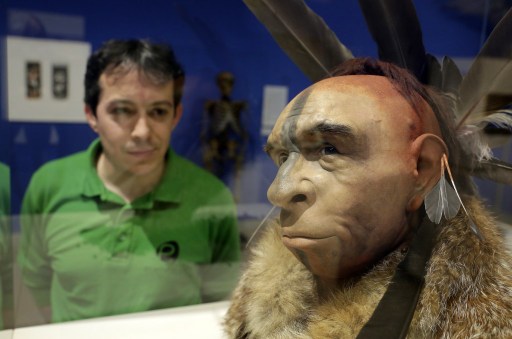For early humans, cannibalism more than just a meal

A visitor looks at ‘El Neandertal Emplumado’, a scientificly based impression of the face of a Neanderthal who lived some 50,000 years ago by Italian scientist Fabio Fogliazza during the inauguration of the exhibition ‘Cambio de Imagen’ (Change of Image) at the Museum of Human Evolution in Burgos on June 10, 2014. AFP FILE PHOTO
When early humans, including our species, ate their own kind it was more likely for ritual purposes than for a nourishing meal, according to an unusual study released Thursday.
Carving up the human body to calculate the caloric value of each part, the study argues that prehistoric cannibalism — while less rare than widely assumed — was a dangerous undertaking offering relatively meagre nutritional rewards.
Kilo for kilo, a wild horse, bear or boar had more than three times the calories in fat and protein than our lean-and-mean human ancestors, who were mostly skin, muscle and bone, according to the research, published in the journal Scientific Reports.
Moreover, human prey — as wily as the hunter — would surely put up a good fight before being sliced up into filets.
“I did the study because I wanted to know how nutritional we are compared to these other animals,” explained James Cole, a senior lecturer in archaeology at the University of Brighton in England.
Article continues after this advertisement“That might tell us whether we, and other human species, were doing it for the calories, or if there is some other explanation,” he told AFP.
Article continues after this advertisementThe findings help flesh out the idea that cannibalism among homo sapiens — as well as Neanderthals, homo erectus and other hominins — was suffused with cultural meaning.
Recent scholarship suggests our ancestors, including Neanderthals, had rich cultures, evidenced by artifacts, jewellery and perhaps language.
“It seems unreasonable to think that early humans wouldn’t have had as complex an attitude to cannibalism as we modern humans,” Cole said.
“They may have had as many reasons to consume each other as we do.”
“It’s not just about the meat,” he added.
Sucking the marrow from a leg bone or gnawing on a spleen might have been a way to affirm territorial control and pay homage to deceased family members, Cole said.
“The consumption of the food in that scenario is a kind of bonus,” he pointed out.
More broadly, the study suggests that our cave- or savannah-dwelling cousins were probably far more sophisticated than we suspect.
‘Brain matter’
A review of the fossil record, along with recent genetic research, shows that cannibalism among hominin species, or early man, was fairly common.
“We don’t have a lot of human remains,” Cole said. “But even within that small sample, we still see quite a lot of evidence of human modification on those remains — butchery, cut marks on the bone — consistent with cannibalism.”
Bones with cut marks at the tendon joints to remove filets of muscle; long arm and leg bones that have been cracked to access the marrow; human teeth marks — all are telltale signs of humans feasting on humans.
The earliest confirmed case of human cannibalism — found in a cave in Spain — features the species homo antecessor and dates back nearly one million years.
Other research has shown that prehistoric humans developed some immunity to diseases, known as transmissible spongiform encephalopathies (TSE), that are spread by eating infected brain matter.
“The only reason an evolutionary adaptation would develop is if you are over-exposed to the pathogens,” Cole said.
That could have arisen when a human ate, say, a lion that had consumed a bovine brain.
The human variant of mad cow disease that erupted in the 1990s spread when people ate beef from cows that had been fed the brains of infected animals.
“Or it comes from eating the brain matter of members of our own species,” as is thought to have occurred with the Fore people of Papua New Guinea, who practiced cannibalism.
A wide range of motivations are used to explain modern-day cannibalism, ranging from psychosis (think of the liver-and-fava-bean loving Hannibal Lecter), to warfare, medicine or funerary ritual. Shipwreck and plane crashes can also lead to survival cannibalism.
But for early humans, Cole said, that complexity has been unjustifiably boiled down to “nutritional” versus “ritual”, with the added presumption that food is usually the main motive.